小学人教PEP版英语五年级上册优质课公开课教学设计Unit4(6).
- 格式:doc
- 大小:58.00 KB
- 文档页数:3
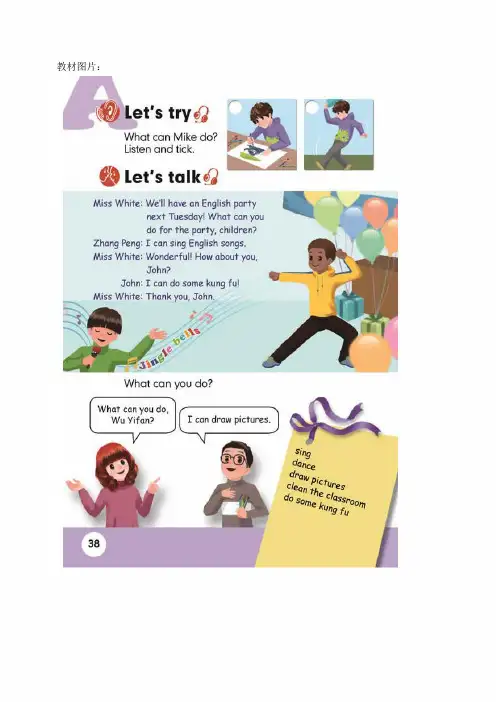
教材图片:Unit4 A Let’s talk公开课教案教材:人教PEP小学英语五年级上册P38单元主题:What can you do?课型:听说课一、教材解析本课时是五年级上册Unit4的第一课时。
本课的主题是派对的举办,主线是“我能做某事”,主要教学内容是A部分的Let’s try和Let’s talk板块。
教学内容贴近学生的生活,容易引起学生的共鸣,调动学生的学习兴趣。
Let’s try为听力活动,听力文本是一段包含核心句型的对话。
学生通过完成听录音选图的活动初步接触核心句型,为Let’s talk板块的教学进行铺垫。
Let’s talk部分学习的核心句型是:What can you do for the party? I can sing English songs. 通过Miss White和张鹏以及John的对话,让学生感知上述功能句型的语义及语用情境。
二、目标预设1. 能够完成听录音选图的活动。
2. 能够在图片和教师的帮助下理解对话的大意;能够按照正确的意群及语音、语调朗读并表演对话。
3. 能够在情景中运用句型What can you do for the party? I can …询问并回答某人能做什么。
三、重难点预设(一)教学重点1. 学生能够理解对话大意,并进行角色扮演。
2. 学生能够在情景中运用句型What can you do? I can …询问并回答某人能做什么事情。
(二)教学难点1. 学生能理解We’ll …的含义和用法。
2. 学生能在具体情景中主动进行知识迁移,运用句型What can you do? I can … 进行拓展表达。
四、教学过程(一)热身(Warm-up)1. 师生相互问候,练习课堂口语。
2. Game: I say you do教师说之前所学动词或动词词组,学生做动作,进行课堂热身。
(二)呈现新课(Presentation)1. 教师呈现本月日历,问学生今天是星期几,引出书中人物下周会有一个英语派对。
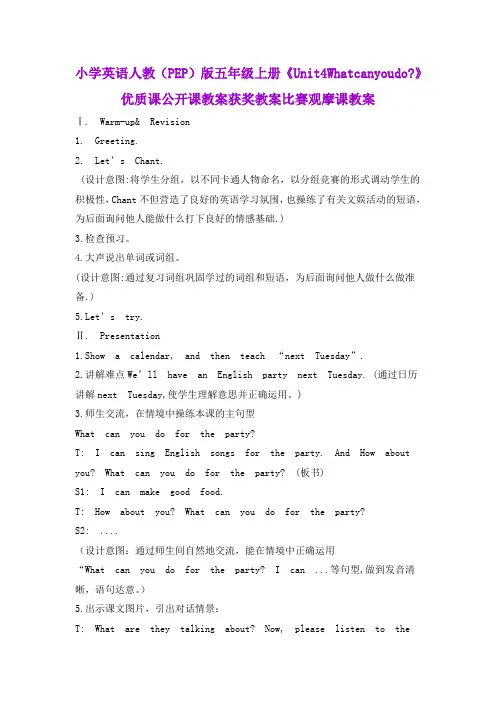
小学英语人教(PEP)版五年级上册《Unit4Whatcanyoudo?》优质课公开课教案获奖教案比赛观摩课教案Ⅰ.Warm-up& Revision1. Greeting.2. Let’s Chant.(设计意图:将学生分组,以不同卡通人物命名,以分组竞赛的形式调动学生的积极性,Chant不但营造了良好的英语学习氛围,也操练了有关文娱活动的短语,为后面询问他人能做什么打下良好的情感基础.)3.检查预习。
4.大声说出单词或词组。
(设计意图:通过复习词组巩固学过的词组和短语,为后面询问他人做什么做准备.)5.Let’s try.Ⅱ.Presentation1.Show a calendar, and then teach “next Tuesday”.2.讲解难点We’ll have an English party next Tuesday. (通过日历讲解next Tuesday,使学生理解意思并正确运用。
)3.师生交流,在情境中操练本课的主句型What can you do for the party?T: I can sing English songs for the party. And How about you? What can you do for the party? (板书)S1: I can make good food.T: How about you? What can you do for the party?S2: ....(设计意图:通过师生间自然地交流,能在情境中正确运用“What can you do for the party? I can ...等句型,做到发音清晰,语句达意。
)5.出示课文图片,引出对话情景:T: What are they talking about? Now, please listen to the。
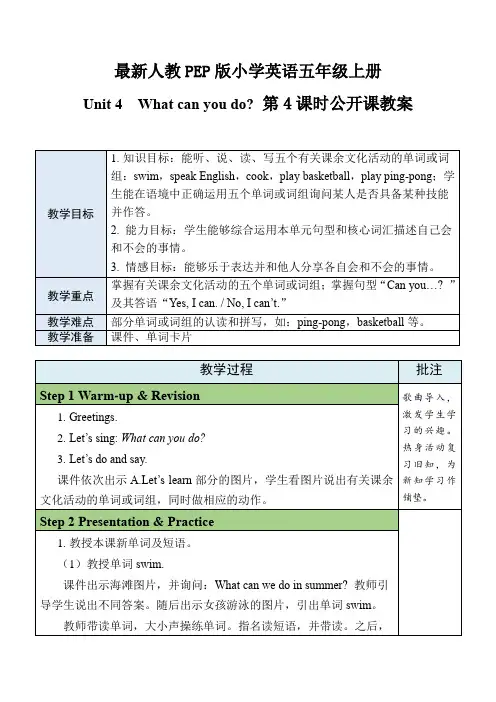
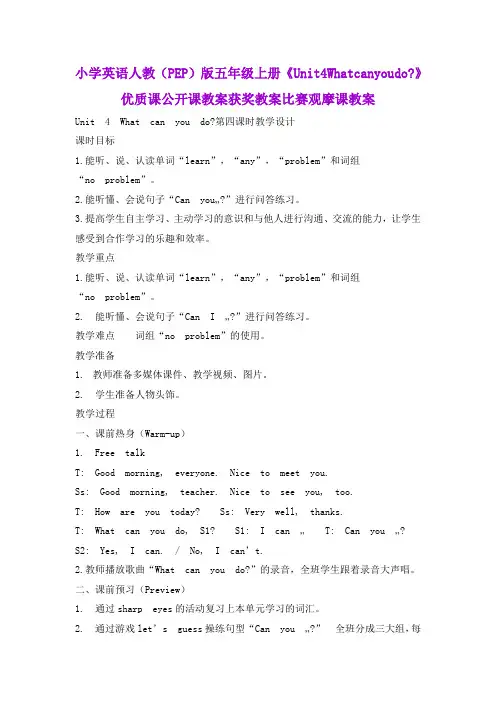
小学英语人教(PEP)版五年级上册《Unit4Whatcanyoudo?》优质课公开课教案获奖教案比赛观摩课教案Unit 4 What can you do?第四课时教学设计课时目标1.能听、说、认读单词“learn”,“any”,“problem”和词组“no problem”。
2.能听懂、会说句子“Can you…?”进行问答练习。
3.提高学生自主学习、主动学习的意识和与他人进行沟通、交流的能力,让学生感受到合作学习的乐趣和效率。
教学重点1.能听、说、认读单词“learn”,“any”,“problem”和词组“no problem”。
2. 能听懂、会说句子“Can I …?”进行问答练习。
教学难点词组“no problem”的使用。
教学准备1.教师准备多媒体课件、教学视频、图片。
2. 学生准备人物头饰。
教学过程一、课前热身(Warm-up)1. Free talkT: Good morning, everyone. Nice to meet you.Ss: Good morning, teacher. Nice to see you, too.T: How are you today? Ss: Very well, thanks.T: What can you do, S1? S1: I can …T: Can you …?S2: Yes, I can. / No, I can’t.2.教师播放歌曲“What can you do?”的录音,全班学生跟着录音大声唱。
二、课前预习(Preview)1. 通过sharp eyes的活动复习上本单元学习的词汇。
2. 通过游戏let’s guess操练句型“Can you …?”全班分成三大组,每。
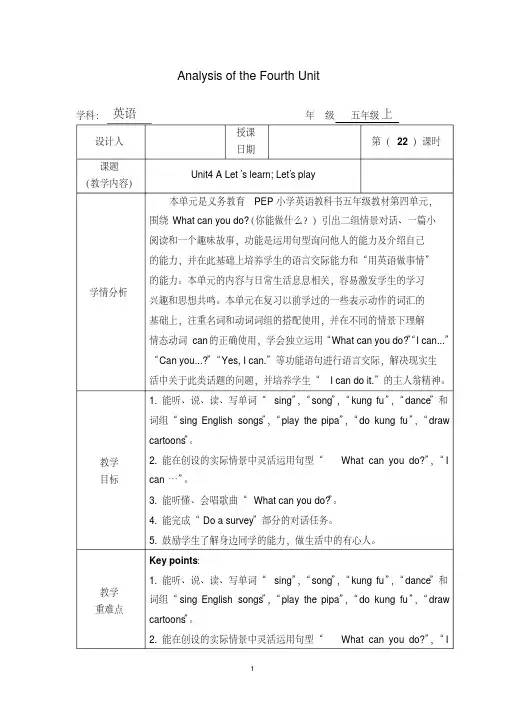
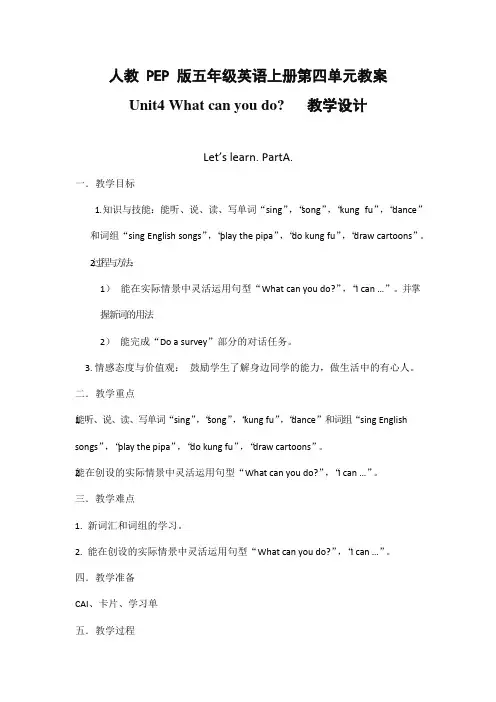
人教 PEP 版五年级英语上册第四单元教案Unit4 What can you do? 教学设计Let’s learn. PartA.一.教学目标1.知识与技能:能听、说、读、写单词“sing”,“song”,“kung fu”,“dance”和词组“sing English songs”,“play the pipa”,“do kung fu”,“draw cartoons”。
2.过程与方法:1)能在实际情景中灵活运用句型“What can you do?”,“I can …”。
并掌握新词的用法2)能完成“Do a survey”部分的对话任务。
3. 情感态度与价值观:鼓励学生了解身边同学的能力,做生活中的有心人。
二.教学重点1.能听、说、读、写单词“sing”,“song”,“kung fu”,“dance”和词组“sing English songs”,“play the pipa”,“do kung fu”,“draw cartoons”。
2.能在创设的实际情景中灵活运用句型“What can you do?”,“I can …”。
三.教学难点1.新词汇和词组的学习。
2.能在创设的实际情景中灵活运用句型“What can you do?”,“I can …”。
四.教学准备CAI、卡片、学习单五.教学过程Step1 .Warm-up1). Free talkT: Good afternoon, everyone. So nice to see you again! How are you?Ss: Fine, thank you. And you?T: I’m fine, too. Are you ready for our class?Ss: Yes.2). Listen to a song: What can you do?Setp2 .Lead-in and brain stormingT: I can run. What about you?S: I can jump.T: Really? Please jump for me!Step3.PreviewTurn to P39.Work in groups, try to understand and read the words and phrases. Step4、Presentation1.A. Let’s learn幸运大抽奖Learn the new words and the new phrases1)danceshow a pictureT: What can you do?S: I can dance.2)Sing English songsT: what can he do?S: Sing songsT: Great. Let’s listen to his songs.Please tell me, Chinese songs or English songs.3)do kung fuT: Look, what’s this??S: kung fu PandaT: yes!The panda can do kung fu! Let’s watch a video.Play a video4)draw cartoonsSay: cartoons5)play the pipaPay attention to “the”2.Practicework in pairs: read the new words and phrases.groupwork: 完成九宫格3.Learn the sentence---What can you do?--- I can …4.Game:S1: what can you do?S2: I can dance. What can you do?S3: I can dance and sing English songs.What can you do?S4: I can dance , sing English songs and draw cartoons.2. A. Do a survey5.Do a survey(1)学生在四人小组内用句型“What can you do?”和“Who can …?”相互调查其他小组成员会做的事情。
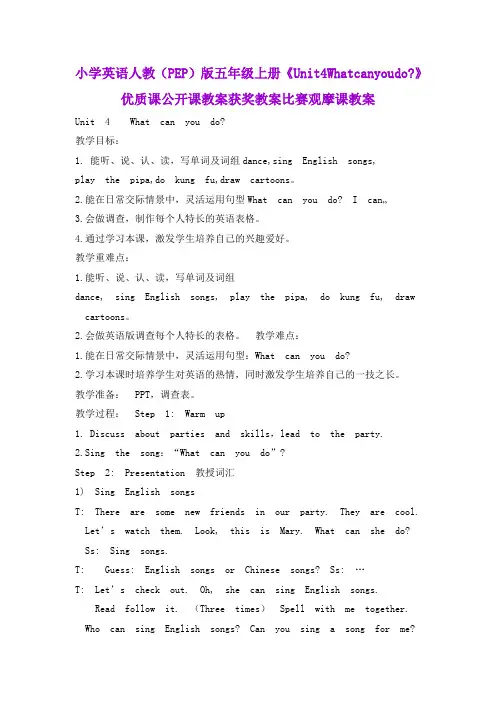
小学英语人教(PEP)版五年级上册《Unit4Whatcanyoudo?》优质课公开课教案获奖教案比赛观摩课教案Unit 4 What can you do?教学目标:1.能听、说、认、读,写单词及词组dance,sing English songs,play the pipa,do kung fu,draw cartoons。
2.能在日常交际情景中,灵活运用句型What can you do? I can…3.会做调查,制作每个人特长的英语表格。
4.通过学习本课,激发学生培养自己的兴趣爱好。
教学重难点:1.能听、说、认、读,写单词及词组dance, sing English songs, play the pipa, do kung fu, draw cartoons。
2.会做英语版调查每个人特长的表格。
教学难点:1.能在日常交际情景中,灵活运用句型:What can you do?2.学习本课时培养学生对英语的热情,同时激发学生培养自己的一技之长。
教学准备:PPT,调查表。
教学过程:Step 1: Warm up1.Discuss about parties and skills,lead to the party.2.Sing the song:“What can you do”?Step 2: Presentation 教授词汇1) Sing English songsT: There are some new friends in our party. They are cool. Let’s watch them. Look, this is Mary. What can she do? Ss: Sing songs.T: Guess: English songs or Chinese songs? Ss: …T: Let’s check out. Oh, she can sing English songs.Read follow it. (Three times)Spell with me together. Who can sing English songs? Can you sing a song for me?。
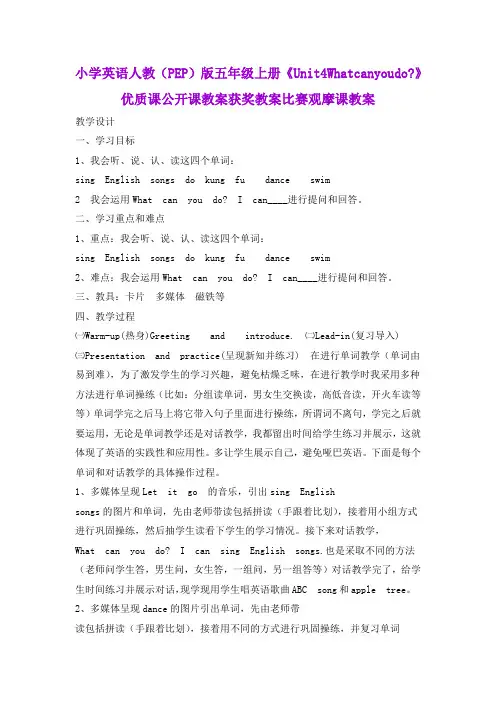
矿产资源开发利用方案编写内容要求及审查大纲
矿产资源开发利用方案编写内容要求及《矿产资源开发利用方案》审查大纲一、概述
㈠矿区位置、隶属关系和企业性质。
如为改扩建矿山, 应说明矿山现状、
特点及存在的主要问题。
㈡编制依据
(1简述项目前期工作进展情况及与有关方面对项目的意向性协议情况。
(2 列出开发利用方案编制所依据的主要基础性资料的名称。
如经储量管理部门认定的矿区地质勘探报告、选矿试验报告、加工利用试验报告、工程地质初评资料、矿区水文资料和供水资料等。
对改、扩建矿山应有生产实际资料, 如矿山总平面现状图、矿床开拓系统图、采场现状图和主要采选设备清单等。
二、矿产品需求现状和预测
㈠该矿产在国内需求情况和市场供应情况
1、矿产品现状及加工利用趋向。
2、国内近、远期的需求量及主要销向预测。
㈡产品价格分析
1、国内矿产品价格现状。
2、矿产品价格稳定性及变化趋势。
三、矿产资源概况
㈠矿区总体概况
1、矿区总体规划情况。
2、矿区矿产资源概况。
3、该设计与矿区总体开发的关系。
㈡该设计项目的资源概况
1、矿床地质及构造特征。
2、矿床开采技术条件及水文地质条件。
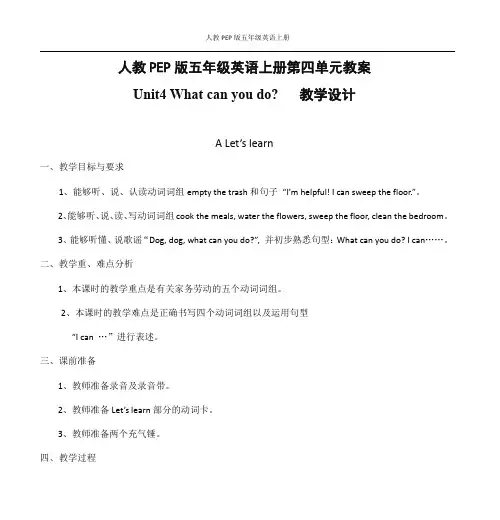
人教PEP版五年级英语上册第四单元教案Unit4What can you do?教学设计A Let’s learn一、教学目标与要求1、能够听、说、认读动词词组empty the trash和句子“I’m helpful!I can sweep the floor.”。
2、能够听、说、读、写动词词组cook the meals,water the flowers,sweep the floor,clean the bedroom。
3、能够听懂、说歌谣“Dog,dog,what can you do?”,并初步熟悉句型:What can you do?I can……。
二、教学重、难点分析1、本课时的教学重点是有关家务劳动的五个动词词组。
2、本课时的教学难点是正确书写四个动词词组以及运用句型“I can…”进行表述。
三、课前准备1、教师准备录音及录音带。
2、教师准备Let’s learn部分的动词卡。
3、教师准备两个充气锤。
四、教学过程1、热身(Warm up)播放三年级上册第二单元C部分的歌曲“Colour Song”,全班学生一起进行表演唱。
把全班同学分为七个小组分别代表一种颜色。
唱到哪一种颜色的代表该颜色的小组就起立并拍手,唱到“I can sing a rainbow.”时,学生可以适当的身体语言表现彩虹的形态。
2、预习(preview)Lets startT:How many door/lights/boards/…can you see?S:I can see…让学生看Let’s start部分的挂图。
T:I can clean the board.What can you do?引导学生用“I can…”回答,并鼓励学生尽量多地利用已学动词(词组)。
3、新课呈现(Presentation)Let’s learn(1)教师在黑板上画一些花,说:I can draw flowers.教师边做浇花的动作边说:Look!I can water the flowers.I’m helpful!同时板书:I’m helpful!I can water the flowers.然后教师问学生:Can you?引导学生做出回答。
课
题:
BOOKV Unit 4 What Can You Do?
第六课
时
教学
内容:
BOOKV Unit 4 B: Read and write. C: Pronunciation.
教学
目标:
1、能听说读写can’t=can not 和use a computer这两个词组。
2、掌握or/ pl/ all/ pr四个字母组合的发音规律并结合以前所学的
语音知识,进一步提高学生自我拼读、认读单词的能力。
3、成学生正确的书写习惯。
重点
难点:
四会掌握句型“Can you„? Yes, I can. / No, I can’t.”
教具准备: Recorder, tapes, cards, pictures. 理论依
据
教
学
过
程
Step 1 Warm-up
1、生生对话,主要围绕“What can you do? Can you„?”这两个
句型进行,鼓励学生结合以前所学的内容。
2、学生利用上堂课中调查表格来介绍一位自己的朋友能做的家务,
尽量介绍的具体、全面。如:XiaoMing is my friend. He is tall and
strong and he can water the flowers。
3、多媒体呈现学生熟悉的卡通人物,请学生用“What can he/she
do ? Can he /she„”来询问并做出相应回答。
Step 2 Presentation
1、教师出示Robot的图片,听录音一遍,请学生说说Robot能做什
么。
2、难道Robot什么都能做吗?有学生可能会回答不是,引出can’t
的教学,请学生再次听录音,回答Robot不能做什么。
3、学对话。
4、师生对话,引出句型Who can?的教学
T: What can you do , B?
B: I can cook the meals.
T: Can you wash the clothes?
B: Sorry, I can’t.
T: Who can?
C: I can wash the clothes.
5、学生三人自由组合进行如上对话。
6、Pronunciation的教学
(1)教师呈现一个单词short,手持含有相同字母组合or的单词(如
fork)的学生迅速站起来,拼读单词。
(2)出示单词short,请学生找含有字母组合or且发音相同的单词,
可翻书甚至可以去查字典。
(3)让学生动脑筋看这些单词有什么特点。
(4)教师准备一些新单词,这些单词具有以上的特点,让学生准确
的读出。
(5)读出后面的绕口令。
Step 3 Practice
活动一:学生独立完成Read and write中的表格填写。
活动二:I’m Robot
请学生戴上Robot的面具,假设自己是Robot来介绍自己能做的
和不能做的事,提醒学生注意模仿Robot的声音及形态等。
活动三:看谁反应快
五人围成一个圈,第一个学生说出一个词组,第二个学生重复第一个
词组并且再加一个词组,所加词组不能重复,以此类推。如第一位:
Empty the trash.第二位:Empty the trash. Clean the bedroom.
活动四:比一比谁写的多
教师把六张四会词组卡片贴在黑板上,给学生十秒钟的时间记忆,然
后拿掉词卡,请学生按照所排的顺序将这些词组写下来,写的既快又
规范的获胜。(在做此活动之前应给学生一定的准备时间。)
Step 4 Consolidation
1、完成配套的活动手册练习。
2、让学生听本单元的对话录音,读给家长或同伴听。
教 学 反 思 学生能较快背出课文,但四会句子“Can you use the computer?最难掌
握。